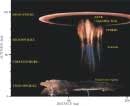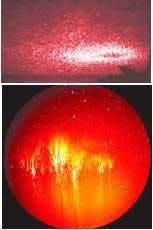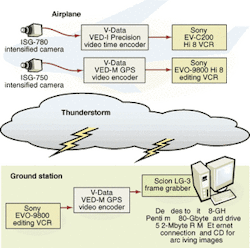Image system enhances lightning flashes
To a reconnaissance satellite, bright flashes in the sky that are kilometers in diameter—known as Sprites and Elves—can look more threatening than a mesospheric response to a lightning storm. In fact, Sprites and Elves (emissions of light and very-low-frequency perturbations from electromagnetically pulsed sources) are little-understood "glow discharges" that typically occur between clouds in large, active mesoscale lightning storms and the ionosphere. While a vertically aligned Sprite, which resembles a top-heavy carrot or a tentacle jellyfish, can last from tens to hundreds of milliseconds, the horizontal expanding circle of light that is an Elve might exist for less than a millisecond. In comparison, lightning strikes activate for only a tenth of a millisecond (see Fig. 1).
Sprites were theoretically described in 1920, but proof of their existence did not come until 1990, when space-shuttle astronauts and University of Minnesota (Minneapolis, MN) faculty member John Winckler separately recorded Sprites on video. NASA and US Air Force researchers have determined that these phenomena in the sky do not appear to harm passing rockets or satellites, but questions remain on how these energetic events are connected to weather and to the chemical balance of the mesosphere and lower ionosphere.
The National Science Foundation (Arlington, VA) and Utah State University (Logan, UT) researcher Mike Taylor collect Sprite and Elve videos to look for emission spikes that indicate the existence of excited and ionized molecular nitrogen. To obtain these videos he uses equipment installed in high-flying aircraft, including an ITT (previously Xybion, Cedar Knolls, NJ) Gen III intensified camera, a Barr Associates (Westford, MA) narrow-bandwidth interference filter, a V-Data (Lottsburg, VA) global-positioning-system (GPS) encoder/decoder, and a Sony Corp. (Tokyo, Japan) Hi 8 EV-S9000 video cassette recorder (VCR), to isolate and identify individual Sprites and Elves.
In a ground station, the analog tapes of gathered data are digitized on a Dell Computer Corp. (Round Rock, TX) desktop PC using a Scion Corp. (Frederick, MD) LG-3 frame grabber. Space locations are determined using local star positions, GPS coordinates, and proprietary software. Lastly, the Sprite data are analyzed by Research Systems Inc. (Boulder, CO) Interactive Data Language (IDL) data-analysis software to better understand these energetic atmospheric events that dwarf lightning strikes both spatially and temporally.
Higher energy
Sprites and Elves overwhelm lightning bolts in size and time. The wide dispersion of their high electrical energy through thinning atmosphere over hundreds of milliseconds poses challenges when collecting data on their location, size, and shape (see Fig. 2). "Although Sprites are visible to a dark-adapted eye, Elves are not," Taylor says. "The rugged Xybion cameras combine a high-gain image intensifier and electronics to get superior signals."
FIGURE 2. Elves are extremely difficult to image due to their highly transient nature. A characteristic "donut-shaped" Elve was captured on a single video field by a NASA aircraft flying over southern Europe (top). The image has been false-colored and contrasted to highlight the event. Note an aircraft wing at bottom right of image. Another false-color image shows a cluster of Sprites imaged in the nitrogen's first positive emission at 665 nm. Sprites are often characterized by a diffuse "head" region that is coupled to a complex structured body with long dangling tendrils. This Sprite cluster extends from an altitude of about 90 km down to about 40 km (bottom).
Taylor uses ITT/Xybion ISG-780 and ISG-750 gated, low-light-intensified CCD cameras. "In these versions, the control panel is located at the back of the camera, which makes them easier to control in the dark on an airplane and in the ground station. Both cameras allow us to work in field mode, which is critical to imaging short-duration events," Taylor explains.
The ISG-type cameras require 16.7 ms to acquire one-half of an NTSC frame, or one field. Because Sprites may last only several milliseconds, and Elves even less, low noise and high temporal resolution are important camera features for isolating individual events. Scientists estimate that Sprites appear for only one in every 200 lightning strikes, or at the rate of several each minute worldwide.
Each camera is fitted with one of several narrow interference or notch filters, such as a Barr Associates notch filter with a 10-nm bandwidth centered around 665 nm, for detecting nitrogen emissions or a series of broadband filters for measuring ionized nitrogen in the blue spectrum. "Most intensified CCDs are sensitive in the red spectrum, but Xybion pushed the blue sensitivity with the ISG-780 camera. Theory says we should expect ionization with Sprites, and measurements of their blue emissions can yield information on their ionization," Taylor says.
FIGURE 3. In an airplane, two Xybion cameras and V-Data's global positioning system (GPS) and time encoders allow researchers to work in field mode rather than frame mode. Field mode is critical to capturing events that are both faint and short-lived. Analog signals from the two cameras are fed separately through coaxial cables to a VED-I precision video time encoder and a VED-M GPS video encoder/decoder, respectively. In the ground station, the VED-M GPS system overlays the airplane's direction, altitude, and speed onto the edge of each field of one video stream. The analog stream is then stored and analyzed on videocassette recorders.
The analog signals from the two cameras are fed separately through coaxial cables to a V-Data VED-I precision video time encoder and a VED-M GPS video encoder/decoder, respectively (see Fig. 3). Both V-Data encoders time-stamp each NTSC field with millisecond accuracy. In the ground station, the VED-M GPS system overlays the airplane's direction, altitude, and speed onto the edge of each field of one video stream. The analog stream is then stored separately on a Sony EV-C200 Hi-8 VCR and an EVO-9800 Hi-8 VCR. After data collection, the EVO-9800 VCR is used for analysis.
A Sprite or Elve is cued on the EVO-9800 VCR and fed across a coaxial cable to the VED-M GPS encoder/decoder, which displays the airplane's position, direction, and speed at the time the field was imaged. A second coaxial cable connects the VED-M to a Scion LG-3 8-bit, gray-scale frame grabber with 4 Mbytes of on-board RAM memory. This memory holds up to 2 s of video, enough to isolate a Sprite or Elve. The frame-grabber board resides in a standard Dell desktop PC with a 1.8-GHz Pentium 4 processor, an 80-Gbyte hard drive, and 512 Mbytes of RAM for manipulating the images.
Software developed in-house by Taylor's group takes each image field from the frame grabber and displays it along with the star field in the image's background. "You click on several bright reference stars in the picture, identify the stars, and the software uses a least-squares approach to determine the Sprite's location in the sky based on the star-field and GPS information. This software works with virtually any image file type as long as we understand the header size and information," explains Taylor. It also can stretch the contrast, spatially calibrate the images, create 2-D intensity plots, and flat-field the data to compensate for optics distortion.
The IDL software spatially maps the Sprite and Elve features, which is important for triangulation. Taylor plans to use IDL software to map simultaneous spectral spatial features from red- and blue-filtered images of a single Sprite to determine regions of enhanced ionization within the Sprite, when the system moves to digital recording and storage (see Fig. 4).
null
Digital measurements
Taylor's group is preparing the imaging system for use in Brazil, where the researchers will spend three to four weeks collecting Sprite and Elve data in collaboration with high-flying balloon measurements being made by the University of Washington (Seattle, WA). The balloon will fly over the Sprite storms, and cameras installed in small aircraft will measure the optical signals.
Taylor expects to use digital recordings that should boost the IDL software capability to estimate ion and chemical concentrations based on spectral response and intensity. He also plans on using faster-frame-rate cameras—both intensified and visible—to acquire up to 2000 frames per second to better study the dynamics of Sprite evolution during an event.
R. Winn Hardin, Contributing Editor




